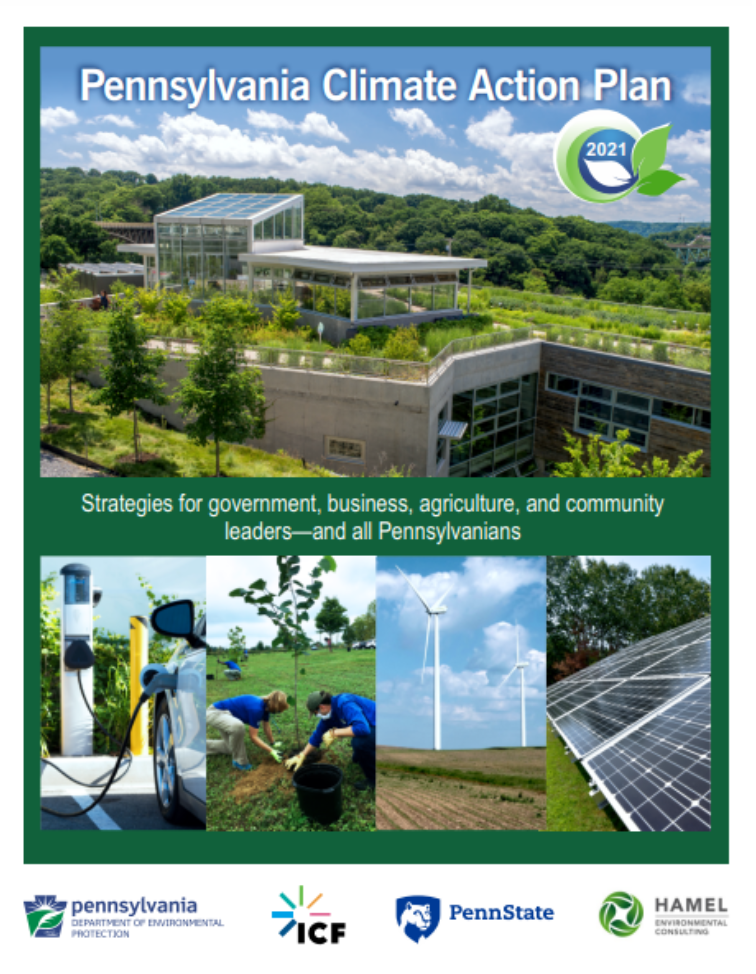By Fawn Contreras in collaboration with other members of the PA Chapter Zero Waste Team
This article is one in a series by the PA Chapter Conservation Teams reviewing the 2021 PA Climate Action Plan.

Image: Cover of the 2021 PA Climate Action Plan from PA DEP
Climate change is here. Floods and severe storms are already impacting Pennsylvanians with evacuations, power outages, damage to bridges, roads, homes, and businesses. The PA Climate Action Plan (CAP) is a source of 18 strategies for those in power to make changes that according to Secretary Patrick McDonnell, “will enable us to lessen negative impacts and capitalize on any potential opportunities created by climate change.” We would like to highlight and share our thoughts about the points in the CAP that deal with waste, what is in the plan, how it will impact the people, and ways the CAP could be improved.
After a general introduction of the state of greenhouse gas (GHG) emissions in PA, several strategies for reducing them were presented in the CAP. Sadly, NO STRATEGIES to reduce waste sector emissions were modeled for the CAP! According to the report, only 2% of GHG emissions came from the waste sector in 2017. However, is 2% an accurate number, when you look at how food waste alone accounts for 10% of GHG emissions (See Driven to Waste: The Global Food Loss on Farms)? Municipal solid waste (MSW) landfills are the third-largest source of human-related methane emissions in the United States, accounting for approximately 15.1 percent of these emissions in 2019. The waste sector includes all activities related to the collection, transportation, processing, and disposal of waste, which primarily comes from landfills, incinerators, and wastewater treatment plants. Considering that in 2016 8.7 million tons of municipal solid waste was collected, hauled, and disposed of in the state (this is about 1,360 pounds per person!), we feel this should be an area the CAP covered more. Despite a mention of reducing food waste as a goal, the CAP did not include any strategies to solve this one sector that is the largest contributor to municipal waste.

Image from How Can I Get My Small Town To Recycle in Ask Mr Green, Sierra Club Blog
So, since no strategies were suggested in the CAP regarding the Waste sector’s contribution to GHGs, what can we do? Recycling and reusing materials can reduce the amount of waste generated. Unfortunately, recycling rates are falling across the State and country. Many local governments in PA are scaling back or eliminating their recycling programs due to the increased cost and the shrinking market for recyclable materials (see How Can I Get My Small Town To Recycle in Sierra's Ask Mr Green). Since the rate of recycling and capability to recycle are falling, PA should recognize this as the right time to push for a circular system and to implement a zero-waste policy state-wide that is equitable for all.
The plan to increase production and use of biogas/RNG sourcing from landfills and other waste sources is described on page 74 of the CAP. “Renewable Natural Gas” (RNG) is produced by using waste products diverted from landfills and is chemically similar to natural gas but when it is burned, it produces biogenic CO2 which has a modified impact on emissions. Therefore, using RNG vs. natural gas will reduce CO2 emissions. However, RNG combustion does create local air pollution similar to that created by fossil natural gas combustion. Federal and State policies are needed to regulate this.
Biogas is produced when the landfill is anaerobically decomposing. The biogas created in landfills is created from organic materials; this does not factor in the non-organic materials in landfills that leak into and pollute the communities and land around landfills. Instead of focusing on how to harvest energy from landfills, we should develop plans - including a zero-waste model - to reduce the waste going into landfills from the start. The organic materials going to landfills could be dramatically reduced if we had a focus on composting. Local municipalities should increase curbside compost pick up to include yard and food waste. Schools and restaurants should have programs to compost and recycle. Sierra Club policy opposes landfill gas-to-energy facilities as well as waste-to-energy (incineration). Organic material should be fully diverted from landfills to be processed in digesters. (See Sierra Club's Landfill Gas Report & Landfill Gas Q&A)
The summer of 2021 brought record rain and flooding to PA and the mitigation and environmental justice strategies outlined in the CAP are much needed. However, much more needs to be done to address the aftermath of such heavy rains, strong winds, and mass flooding: clogged storm drains, piles of electronics and household waste put out for garbage pick up, and all the litter that is swept downstream. Planting trees, making infrastructure changes to collect and stop the litter from going into drains/rivers, and increasing public awareness of how detrimental (and costly) litter that flows into our storm drains is to our environment will help.
Waste is in every part of our lives. With systems and support in place, we could reduce much of the waste created. Waste was not sufficiently addressed in the CAP. However, we feel that by creating change in reducing our waste and handling waste better, we would be creating a much greener future.
This blog was included as part of the January 2022 Sylvanian newsletter. Please click here to check out more articles from this edition!